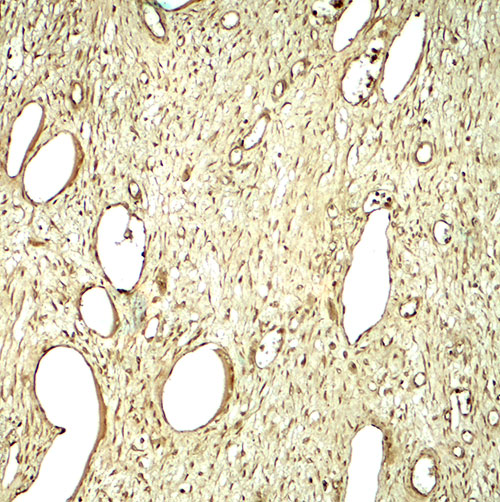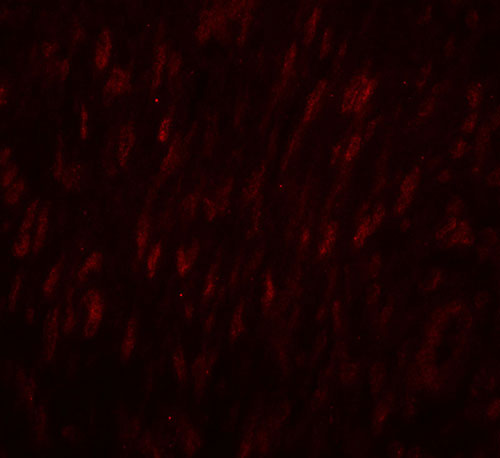SLC29A1 Antibody
- SPECIFICATION
- CITATIONS
- PROTOCOLS
- BACKGROUND

Application
| WB, IHC-P, IF, E |
|---|---|
| Primary Accession | Q99808 |
| Other Accession | NP_004946, 4826716 |
| Reactivity | Human |
| Host | Rabbit |
| Clonality | Polyclonal |
| Isotype | IgG |
| Calculated MW | Predicted: 50 kDa Observed: 53 kDa |
| Application Notes | SLC29A1 antibody can be used for detection of SLC29A1 by Western blot at 1 - 2 µg/mL. Antibody can also be used for immunohistochemistry starting at 5 µg/mL. For immunofluorescence start at 20 µg/mL. |
| Gene ID | 2030 |
|---|---|
| Target/Specificity | SLC29A1; SLC29A1 antibody is human specific. SLC29A1 antibody is predicted to not cross-react with other SLC29 proteins. |
| Reconstitution & Storage | SLC29A1 antibody can be stored at 4℃ for three months and -20℃, stable for up to one year. |
| Precautions | SLC29A1 Antibody is for research use only and not for use in diagnostic or therapeutic procedures. |
| Name | SLC29A1 (HGNC:11003) |
|---|---|
| Synonyms | ENT1 |
| Function | Uniporter involved in the facilitative transport of nucleosides and nucleobases, and contributes to maintaining their cellular homeostasis (PubMed:8986748, PubMed:10755314, PubMed:12527552, PubMed:10722669, PubMed:21795683, PubMed:35790189, PubMed:27995448, PubMed:17379602, PubMed:14759222, PubMed:15037197, PubMed:26406980). Functions as a Na(+)-independent transporter (PubMed:8986748). Involved in the transport of nucleosides such as adenosine, guanosine, inosine, uridine, thymidine and cytidine (PubMed:8986748, PubMed:10755314, PubMed:12527552, PubMed:10722669, PubMed:17379602, PubMed:14759222, PubMed:15037197, PubMed:26406980). Also transports purine nucleobases (hypoxanthine, adenine, guanine) and pyrimidine nucleobases (thymine, uracil) (PubMed:21795683, PubMed:27995448). Mediates basolateral nucleoside uptake into Sertoli cells, thereby regulating the transport of nucleosides in testis across the blood-testis barrier (By similarity). Regulates inosine levels in brown adipocytes tissues (BAT) and extracellular inosine levels, which controls BAT-dependent energy expenditure (PubMed:35790189). |
| Cellular Location | Basolateral cell membrane; Multi-pass membrane protein. Apical cell membrane; Multi-pass membrane protein. Cell membrane; Multi-pass membrane protein. Note=Localized to the basolateral membrane of Sertoli cells (PubMed:23639800). Localized to the cell membrane of erythrocytes (PubMed:23219802, PubMed:11584005). |
| Tissue Location | Expressed in testis at the blood-testis barrier (at protein level) (PubMed:23639800). Detected in erythrocytes (at protein level) (PubMed:23219802, PubMed:11584005). Expressed at relatively high levels in cerebral cortex, particularly the frontal and parietal lobes, and the thalamus and basal ganglia (at protein level) (PubMed:11311901). In the midbrain expressed at moderate levels, whereas in the other areas of the brainstem, namely medulla and pons, cerebellum and the hippocampus expressed at lower amounts when compared to the other brain regions (at protein level) (PubMed:11311901) Expressed in Langerhans cells and lymphocytes in the pancreas (at protein level) (PubMed:15501974). Expressed in kidney, in polarized renal epithelial cells (PubMed:12527552). Expressed in adipose tissues (PubMed:35790189). Expressed in placenta (PubMed:8986748). Expressed in small intestine (PubMed:10755314). |

Thousands of laboratories across the world have published research that depended on the performance of antibodies from Abcepta to advance their research. Check out links to articles that cite our products in major peer-reviewed journals, organized by research category.
info@abcepta.com, and receive a free "I Love Antibodies" mug.
Provided below are standard protocols that you may find useful for product applications.
Background
SLC29A1 is a member of the equilibrative nucleoside transporter family which plays a key role in nucleoside and nucleobase uptake for salvage pathways of nucleotide synthesis (1,2). SLC29A1 is a transmembrane glycoprotein that localizes to the plasma and mitochondrial membranes and mediates the cellular uptake of nucleosides from the surrounding medium (3). As a nucleoside transporter, SLC29A1 plays an important role in the uptake of nucleoside-based anti-cancer drugs; polymorphisms of point mutations in the gene encoding this protein may affect the efficacy of these drugs (4).
References
Griffiths M, Beaumont N, Yao SY, et al. Cloning of a human nucleoside transporter implicated in the cellular uptake of adenosine and chemotherapeutic drugs. Nat. Med. 1997; 3:89-93.
Young JD, Yao SY, Baldwin JM, et al. The human concentrative and equilibrative nucleoside transporter families, SLC28 and SLC29. Mol. Aspects. Med. 34:529-47.
Mangravite LM, Xiao G, and Giacomini KM. Localization of human equilibrative nucleoside transporters, hENT1 and hENT2, in renal epithelial cells. Am. J. Physiol. Renal Physiol. 284:F902-10.
Zimmerman EI, Huang M, Leisewitz AV, et al. Identification of a novel point mutation in ENT1 that confers resistance to Ara-C in human T cell leukemia CCRF-CEM cells. FEBS Lett. 2009; 583:425-9.
If you have used an Abcepta product and would like to share how it has performed, please click on the "Submit Review" button and provide the requested information. Our staff will examine and post your review and contact you if needed.
If you have any additional inquiries please email technical services at tech@abcepta.com.













 Foundational characteristics of cancer include proliferation, angiogenesis, migration, evasion of apoptosis, and cellular immortality. Find key markers for these cellular processes and antibodies to detect them.
Foundational characteristics of cancer include proliferation, angiogenesis, migration, evasion of apoptosis, and cellular immortality. Find key markers for these cellular processes and antibodies to detect them. The SUMOplot™ Analysis Program predicts and scores sumoylation sites in your protein. SUMOylation is a post-translational modification involved in various cellular processes, such as nuclear-cytosolic transport, transcriptional regulation, apoptosis, protein stability, response to stress, and progression through the cell cycle.
The SUMOplot™ Analysis Program predicts and scores sumoylation sites in your protein. SUMOylation is a post-translational modification involved in various cellular processes, such as nuclear-cytosolic transport, transcriptional regulation, apoptosis, protein stability, response to stress, and progression through the cell cycle. The Autophagy Receptor Motif Plotter predicts and scores autophagy receptor binding sites in your protein. Identifying proteins connected to this pathway is critical to understanding the role of autophagy in physiological as well as pathological processes such as development, differentiation, neurodegenerative diseases, stress, infection, and cancer.
The Autophagy Receptor Motif Plotter predicts and scores autophagy receptor binding sites in your protein. Identifying proteins connected to this pathway is critical to understanding the role of autophagy in physiological as well as pathological processes such as development, differentiation, neurodegenerative diseases, stress, infection, and cancer.




